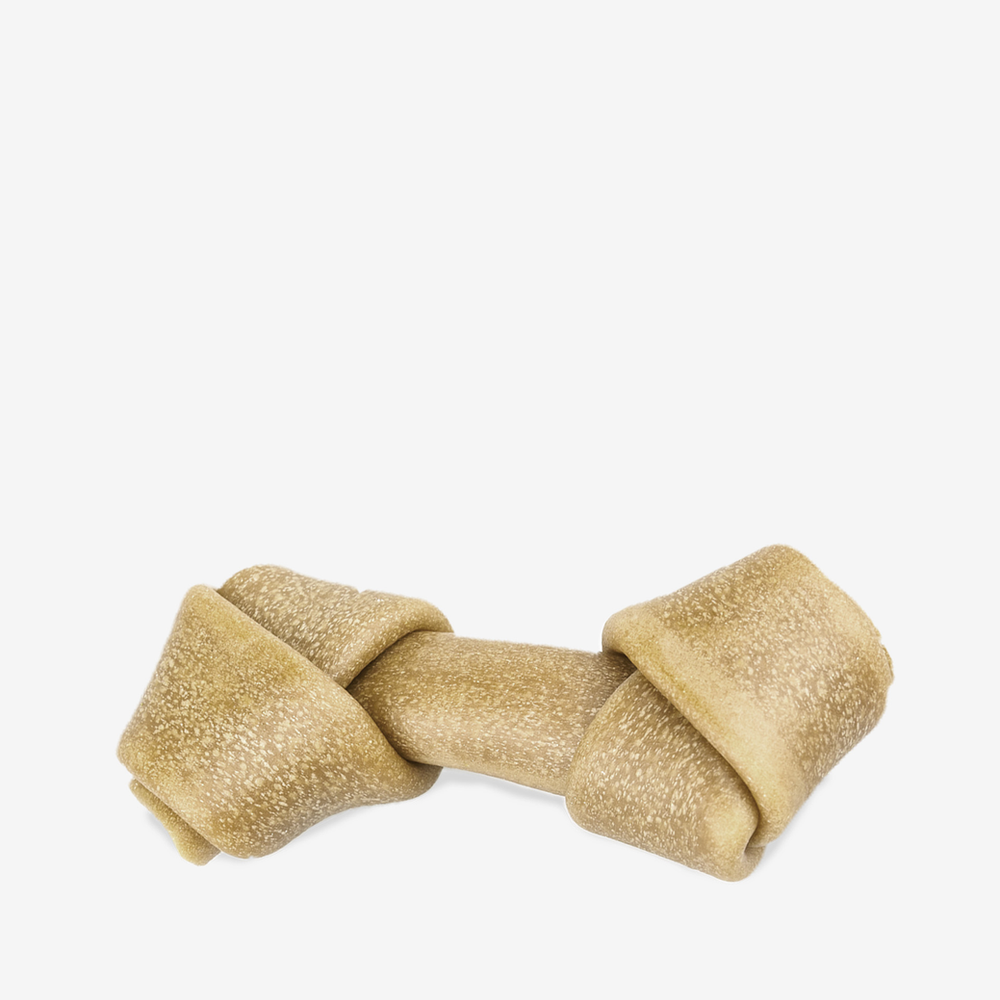
Canine nutritionist’s guide to feeding your dog raw, meaty bones
If a dog’s prayers were answered, bones would probably rain from the sky. The canine-bone love affair is probably more than many millennia-old and for good reason. If done right, bones can provide dogs with supplemental nutrition, immunity boost and mental stimulation that is so very important for stress relief.
However, there’s one ground rule to this: Always feed your dog raw bones.

Raw, meaty bones or RMBs are real animal bones – different from bleached white rawhide bones available in pet stores. Watch this Video here to know the dangers of Rawhide bones for your dog.
From feet and trotters, tails to the scapula, there are different kinds of raw bones that you can offer your dog thats are safe and healthy.
To save you from going down the rabbit hole of information about feeding raw meaty bones, we’ve put together this guide. Here’s everything you need to know about feeding your dog raw, meaty bones.
Why are raw, meaty bones an excellent addition to your dog’s diet?
Chewing bones regularly removes plaque build-up, reduces bad breath, cleans their teeth. But meaty bones go further.
Packed with nutrition and an immunity booster
Natural, real bones are excellent sources of nutrition. These bones come with cartilage, sinew, marrow and other soft tissue, all of which contain a chock full of valuable nutrients such as anti-oxidants, phosphorous and calcium – in the proper ratio.
Phosphorous helps in synthesizing protein for growth, maintenance and cell/tissue repair. It also helps in supporting B vitamins, healthy kidney function and good nerve conduction among others.
,According to canine nutrition expert ,Dr Ian Billinghurst, calcium helps in immune, cardiovascular, endocrine and neuromuscular functions.
Here’s a ,quick guide to help you understand the approximate amount of bone in food.

Eating raw meaty bones may cause your dog’s poop to come out crumbly, pellet-like or just a little different – that’s okay. But, if your dog is pooping our pieces of bone after eating RMBs, check with your nutritionist immediately. It could be a sign of a gastric disorder or it could be the bone is not suiting your dog and you may need to try other types of bones.
Calms down hyper dogs and provides powerful pain relief
Yes! Chewing on raw, meaty bones can help boost your dog’s mood and alleviate stress and pain. The endorphins released during a good chew session act as powerful painkillers – if your dog has joint pain, HD or arthritis, chewing on raw, meaty bones should provide them with some relief. Not to mention that the nutrients from the bone will help with these conditions also.

Chewing is relaxing for your dog. It has a calming effect on hyper dogs and induces restful sleep. Sleep is the most important piece of the jig saw puzzle when it comes to healing the body and dealing with inflammation.
To ensure your dog gets the best of these benefits, it is important to know where your bones come from. We’ve got locally sourced, antibiotic-free and organic meaty bones for your dogs ,here.
Store them in the deep freezer and thaw them just for a few mins one at a time, rinse them under running tap water to give to your dog. Please note that some Dogs will prefer warm or room temperature bones in the winter, while others may not. And in the summer, it might be quite pleasant for them to get a cold bone to chew on! Making these little observations about your dog’s preferences can make bone chewing an even better experience for them.
Cooked bones can choke and injure your dog
You might think that cooking gets rid of all bacteria and pathogens making it safe for your dog’s consumption, but it is far from the truth.
Cooking makes bones indigestible, brittle, more likely to splinter, thus dangerous and takes away any nutrition in it.
It causes the collagen, phosphorus and calcium in the bones to leach away, making it brittle and easily breakable. When your eager dog chews it, it splinters into jagged pieces that can cause the following:
- Choking
- Obstructions and/or tears in the oesophagus, trachea or intestines
- Broken teeth and mouth injuries
- Constipation
- Internal bleeding by piercing internal organs and Peritonitis
So to sum it up, cooked bones not only pose a serious potential risk of injury to your dog, they also offer very little other benefits nutritionally or for calming, better sleep or pain relief – heres how: Most often cooked, baked, dehydrated bones are over sized for the dog. This means one of two things –
1) Your dog will chew on the bone for hours and hours causing jaw, neck, gum pain, and making existing pain much worse. So there goes pain relief benefits out of the window!
2) Because your dog is chewing for hours and not actually finishing the bone, you may feel the need to take the bone away from the dog to give it a rest! THIS can cause stress and anxiety to the dog, which is the opposite of a calming effect we aim for with chewing activities. This can also lead to behavioral problems such as food guarding, hiding bones, wanting to be alone and not watched while chewing on bones, growling, snarling, biting if they perceive you as a “threat” to the bone!
ALL OF THIS is avoided by choosing a RAW MEATY BONE that is the right size for your dog, meaning, that he/she will finish the bone within 25-35 mins. This – a 25-35 min chewing session will give you all the therapeutic, nutritional, oral hygiene and healing benefits we are talking about.
Here’s how you can still “clean” up your bone
You can still disinfect the bone without cooking it. Stick it in the freezer for 14 days, and offer to your dog. Soak it for a couple of minutes in hot water, off the stove. Or simply wash it with running water or hot water to clean it up!
Supervision is crucial
Never give your dog bones without supervision.
Don’t hover over them and appear creepy and suspicious to your dog as they chew (this may lead to the distrust and behavioral issues we mentioned above), but keep an eye out. Even dogs that are used to raw meaty bones can have accidents.
Does this mean you should stop giving bones due to a mishap? Well, we’ve been drinking water since forever and yet, it sometimes goes down the wrong pipe. Do we stop drinking water after it? Not likely, but we are more mindful.
You can read Dr Karen Becker’s article on the importance of supervision, ,here.
Dr. Becker is a respected and renowned veterinarian and she mentions several popular cases that made headlines in the US involving bones, that caused injury or death. She also explains the difference between treat bones (usually small and bite size, mostly cooked or cured or dried or baked) and recreational RAW MEATY BONE chewing. She also goes on to explain how RMB’s are the only safe way to feed your dog bones. And NO other kind are as safe or nutritious.
Another point to note is that 100% of the cases that vets see are to do with an injury or indigestion or accidents to do with bones. Most times, there will be no documentation of; if the bone that caused the injury was cooked, baked, air dried, dehydrated or RAW? If it was a bite size bone or a recreational bone or edible bones like wings, necks etc of birds and poultry.
Secondly, Since Vets only see dogs with injuries, and never the thousands of dogs that eat the right kind of bones safely and enjoy the health benefits that bones offer; there is no documentation of what percentage of the total “bone eating population” does their 100% injury cases represent? Is it 1% of the total population? Is it 6%? Is it 20%? Fact is, there is no way to know. But if several holistic practitioners, integrated Vets like Dr Becker, Dr Jean Dodds, Dr Peter Dobias, Several thousand raw feeders, canine nutritionists, natural rearing advocators are to be believed about their anecdotal, undocumented evidence – it all points to one thing! Feeding raw meaty bones is the safest way of feeding bones. There are several do’s and dont’s that one must look into before simply picking up a bone and handing it to their dog. The dogs will need to be monitored, and you will need to perhaps consult someone to understand what kind of body part, bone shape and size is right for your particular dog. Should your dog be chewing on a bone in the first place, are all things to consider as part of being a responsible parent. So basically, there is a big giant size **Conditions Apply** sign next to the wonderful world of RAW meaty bones! And the due diligence must be done before trying it.
The safe duration to chew is up-to 30 minutes
Some Doggiliciouus clients mention that their dogs often chew their bones for hours and hours on end. This is not healthy. This is also an indication that the dog’s stress levels are very high. However, chewing for this long can not only overrule the amazing benefits of chewing, it can in turn, cause neck and jaw pain due to excessive chewing.

A healthy chewing session the bone is 25 to 35 minutes of chewing time, this does not include the breaks they may take. RMBs, like everything else in your dog’s diet, should be introduced slowly as once a week and can be increased to a couple of times a week, eventually going up to daily chewing sessions. Each dog will have their own individual needs for chewing and how often you give your dog a bone can be manicured to suit these needs. A Canine nutritionist can guide you on this.
While chewing is a great for the back, neck and shoulders, prolonged chewing can lead to jaw/ neck pain, toothache, chipped enamel among other issues. Hence picking the right bone for your dog can become an important skill to acquire.
Picking the right bone for your dog
The perfect bone depends on your dog and their needs. Some dogs can chew through a giant bone in a matter of 30 minutes, while others can’t. Some dogs are power chewers, some a gnawers, some are gobblers, some are lazy chewers. Some trial and error should tell you what category your dog falls in.
According to Dr Becker, a good rule of thumb is to ensure the bone is bigger than your dog’s head to avoid swallowing.
There are also preferences. Some dogs enjoy the flatness of the scapula, while others enjoy trotters. Sometimes these preferences have nothing to do with the size of the bone and is all about texture or soft tissue, cartilage, smell, taste or crunchiness.
While the possibility of it happening is very rare, but some dogs don’t like bones at all. At Doggiliciouus, we’ve met about 2 or 3 out of over a thousand dogs that didn’t want a bone! Go figure. And even these two dogs had chewing needs… we simply had to figure out the appropriate items for them to chew on!
While we do have an approximate chart on how to pick a bone, the perfect one for your dog is the one they enjoy, prefer and cannot gobble up in a matter of minutes.
Conclusion

Feeding raw, meaty bones to your dogs is good! They are not a replacement for a balanced diet for your dog, but they are a really good supplement to their well being. The phosphorus, calcium and collagen from raw, meaty bones add a little extra something to their diet while also calming them, helping them sleep better and providing much-needed pain relief.
One thing to always remember is no matter how it is cooked – steamed, air-dried, boiled, baked or roasted – it makes them brittle and dangerous to your dog. They can cause anything from broken or chipped teeth to perforated organs and intestines.
Adding raw, meaty bones to your dog’s diet is a matter of trial and error. Not all of them will enjoy the same bone from the same animal equally. It is impossible to have a one size fit all bone for all dogs.
Check out our array of different raw, meaty bones for your dogs ,here.
Co-authored and researched by kaunvo.com


